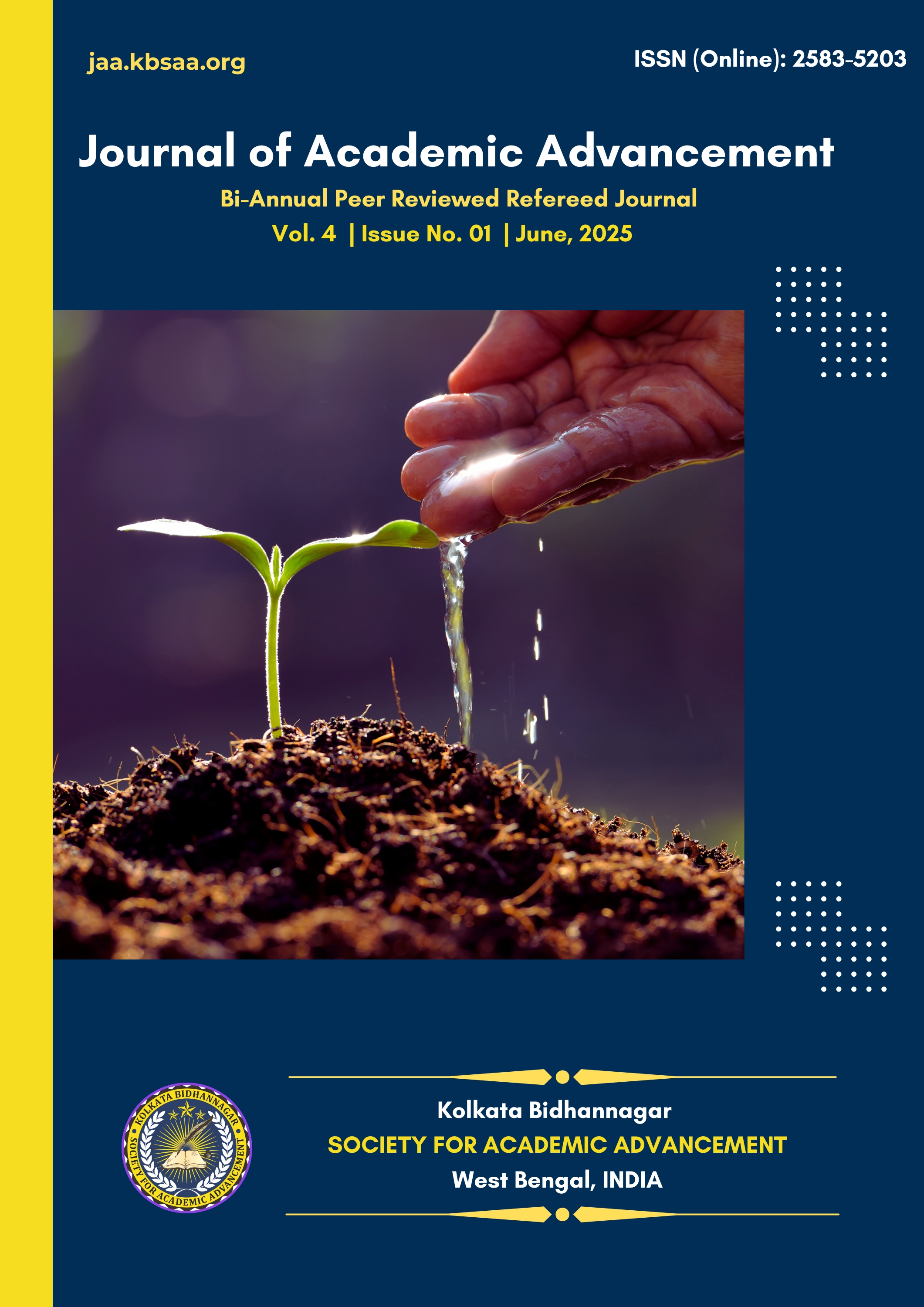Examining the Impact of Financial Socialisation on Financial Preparedness in West Bengal
DOI:
https://doi.org/10.58574/jaa.2024.v4.i1.02Keywords:
Financial Preparedness, Financial Socialisation, Socialisation Agents, Hierarchical, Partial Least SquaresAbstract
The purpose of this article is to evaluate how financial socialisation impacts financial readiness in the region of West Bengal. This connection is depicted in a model based on their hierarchical order of significance. Information was gathered via the administration of questionnaires, and an analysis using a two-stage approach in partial least squares-structural equation modelling (PLS-SEM) was employed for assessing the suitability of hierarchical modelling. The results suggest that financial socialisation takes place through diverse socialisation agents like family, peers, and media, and it positively influences financial readiness. The conceptual attributes of Financial Preparedness align with the reflective-formative nature of the second-order hierarchical component within the models.
The research provides a comprehensive comprehension of the systematic factors necessary to improve financial preparedness in West Bengal. It provides guidance to both the public and the government regarding essential considerations for adequately preparing to meet future financial requirements. Additionally, it offers an alternative approach for researchers aiming to introduce a hierarchical component in Financial Preparedness within different geographical areas.
References
• Ab Hamid, M. R., Sami, W., & Sidek, M. M. (2017, September). Discriminant validity assessment: Use of Fornell & Larcker criterion versus HTMT criterion. In Journal of Physics: Conference Series (Vol. 890, No. 1, p. 012163). IOP Publishing.
• Akash, T. R., Reza, J., & Alam, M. A. (2024). Evaluating financial risk management in corporate financial security systems. World Journal of Advanced Research and Reviews, 23(1), 2203-2213.
• Akben-Selcuk, E., & Aydin, A. E. (2021). Ready or not, here it comes: A model of perceived financial preparedness for retirement. Journal of Adult Development, 28(4), 346-357.
• Alodya, S. T. D. (2021). The effect of financial literacy, parental socialisation and peer influence on saving behaviour and the role of financial attitudes as a mediating variable in the millennial generation of workers in the city of Palembang. Russian Journal of Agricultural and Socio-Economic Sciences, 118(10), 89-97.
• Barua, R., Koh, B., & Mitchell, O. S. (2018). Does financial education enhance financial preparedness? Evidence from a natural experiment in Singapore. Journal of Pension Economics & Finance, 17(3), 254-277.
• Bhargava, V., & Lown, J. M. (2006). Preparedness for financial emergencies: Evidence from the Survey of Consumer Finances. Journal of Financial Counselling and Planning, 17(2).
• Chen, J. M. (2014). Correlation, coverage, and catastrophe: the contours of financial preparedness for disaster. Fordham Envtl. L. Rev., 26, 56.
• Choi, N. G., Marti, C. N., & Choi, B. Y. (2022). Job loss, financial strain, and housing problems as suicide precipitants: Associations with other life stressors. SSM - Population Health, 19, 101243.
• Cong, Z., & Feng, G. (2022). Financial Preparedness for Emergencies: Age Patterns and Multilevel Vulnerabilities. Research on Ageing, 44(3-4), 334-348.
• Curran, M. A., Parrott, E., Ahn, S. Y., Serido, J., & Shim, S. (2018). Young adults’ life outcomes and well-being: Perceived financial socialisation from parents, the romantic partner, and young adults’ financial behaviours. Journal of Family and Economic Issues, 39, 445-456.
• Despard, M. R., Friedline, T., & Martin-West, S. (2020). Why do households lack emergency savings? The role of financial capability. Journal of Family and Economic Issues, 41, 542-557.
• Durante, J. J., & Rosillo, R. (Eds.). (2020). Natural disasters and climate change: Innovative solutions in financial risk management. Springer Nature.
• Fakhruddin, K. A., Pirzada, K., & Iman, M. F. (2022). The role of financial behaviour in mediating the influence of socioeconomic characteristics and neurotic personality traits on financial satisfaction. Cogent Business & Management, 9(1), 2080152.
• Federal Emergency Management Agency. (2020, January 4). National Household Survey 2018.https://www.fema.gov/sites/default/files/2020-08/fema_national-household-survey_2018.zip
• Goyal, K., Kumar, S., & Hoffmann, A. (2023). The direct and indirect effects of financial socialisation and psychological characteristics on young professionals' personal financial management behaviour. International Journal of Bank Marketing, 41(7), 1550-1584.
• Gudmunson, C. G., & Danes, S. M. (2011). Family financial socialisation: Theory and critical review. Journal of Family and Economic Issues, 32, 644-667.
• Gudmunson, C. G., Ray, S. K., & Xiao, J. J. (2016). Financial socialisation. Handbook of consumer finance research, 61-72.
• Hair, J. F., Risher, J. J., Sarstedt, M., & Ringle, C. M. (2019). When to use and how to report the results of PLS-SEM. European Business Review, 31(1), 2-24.
• Imtiaz, S. A., & Shah, S. L. (2008). Treatment of missing values in process data analysis. The Canadian Journal of Chemical Engineering, 86(5), 838-858.
• Jorgensen, B. L., Rappleyea, D. L., Schweichler, J. T., Fang, X., & Moran, M. E. (2017). The Financial Behaviour of Emerging Adults: A Family Financial Socialisation Approach. Journal of Family and Economic Issues, 38, 57-69.
• Kamaruddin, R., & Samsudin, S. (2014). The sustainable livelihoods index: A tool to assess the ability and preparedness of the rural poor in receiving an entrepreneurial project. Journal of Social Economics Research, 1(6), 108-117.
• Kasper, H., Mathur, A., Ong, F. S., Shannon, R., & Yingwattanakul, P. (2019). Contextual influences on financial preparedness of middle-aged workers: a four-country comparative life course study. Journal of Global Scholars of Marketing Science, 29(4), 423-439.
• Khan, M. S., & Ahmad, Z. (2022). The effects of financial literacy and social media on financial behaviour. In Mixed Methods Perspectives on Communication and Social Media Research (pp. 144-164). Routledge.
• Khawar, S., & Sarwar, A. (2021). Financial literacy and financial behaviour with the mediating effect of family financial socialisation in the financial institutions of Lahore, Pakistan. Future Business Journal, 7, 1-11.
• Kim, H., Ekerdt, D. J., & Baker, T. A. (2025). Retirement preparedness: A study of gender, marital status, and motivation factors by using a theory of planned behaviour model. Journal of Women & Ageing, 37(1), 43-55.
• Koochel, E. (2020). Exploring the effects of financial socialisation and trust as it relates to financial well-being and marital satisfaction through stress and communication privacy theories. Kansas State University.
• LeBaron-Black, A. B., Curran, M. A., Hill, E. J., Freeh, M. E., Toomey, R. B., & Speirs, K. E. (2022). Parent Financial Socialisation Scale: Development and preliminary validation. Journal of Family Psychology, 36(6), 943.
• LeBaron, A. B., & Kelley, H. H. (2021). Financial Socialisation: A Decade in Review. Journal of Family and Economic Issues, 42(Suppl 1), 195-206.
• Li, Y. (2023). Pension plan types and Social Security knowledge: New survey evidence. Journal of Ageing & Social Policy, 35(1), 1-19.
• Lusardi, A. (2003). Planning and saving for retirement. Working paper. Dartmouth College.
• Lusardi, A., & Mitchell, O. S. (2011). Financial literacy around the world: an overview. Journal of Pension Economics & Finance, 10(4), 497-508.
• Maniar, A., & Mehta, S. (2021). Challenges and opportunities of elderly working after retirement: Indian scenario. Ageing Issues in India: Practices, Perspectives and Policies, 11-28.
• Marchant, C., & Harrison, T. (2020). Emerging adults' financial capability: A financial socialisation perspective. International Journal of Consumer Studies, 44(2), 99-110.
• Moffatt, S., & Heaven, B. E. N. (2017). Planning for uncertainty: Narratives on retirement transition experiences. Ageing and Society, 37(5), 879–898. doi:10.1017/S0144686X15001476
• Nam, Y., & Loibl, C. (2021). Financial capability and financial planning at the verge of retirement age. Journal of Family and Economic Issues, 42(1), 133-150.
• Sandhu, N. (2017). Television Advertisements and Consumerism: Implications for Financial Health of Viewers. SCMS Journal of Indian Management, 14(4).
• Segel-Karpas, D., & Werner, P. (2014). Perceived financial retirement preparedness and its correlates: A national study in Israel. The International Journal of Ageing and Human Development, 79(4), 279-301.
• Setyorini, N., Indiworo, R. H. E., & Sutrisno, S. (2021). The role of financial literacy and financial planning in increasing financial resilience: household behaviour as a mediating variable. Media Ekonomi dan Manajemen, 36(2), 243-255.
• Shim, S., Barber, B. L., Card, N. A., Xiao, J. J., & Serido, J. (2010). Financial socialisation of first-year college students: The roles of parents, work, and education. Journal of Youth and Adolescence, 39, 1457-1470.
• Vieira, K. M., Rosenblum, T. O. A., Matheis, T. K., Klein, L. L., & Bressan, A. A. (2023). Perception of Financial Well-Being of the Elderly and the Role of Propensity to Indebtedness and Financial Preparation for Retirement. Perception, 13(2), 31-42.
• Yeung, D. Y., & Zhou, X. (2017). Planning for retirement: Longitudinal effect on retirement resources and post-retirement well-being. Frontiers in Psychology, 8, 1300.
• Zhao, H., & Zhang, L. (2020). Talking money at home: The value of family financial socialisation. International Journal of Bank Marketing, 38(7), 1617-1634.
Downloads
Published
How to Cite
License
Copyright (c) 2025 Moupiya Mallick , Sulagna Das

This work is licensed under a Creative Commons Attribution 4.0 International License.
Research Articles in 'Journal of Academic Advancement' are Open Access articles published under the Creative Commons CC BY License Creative Commons Attribution 4.0 International License http://creativecommons.org/licenses/by/4.0/. This license allows you to share – copy and redistribute the material in any medium or format. Adapt – remix, transform, and build upon the material for any purpose, even commercially.







